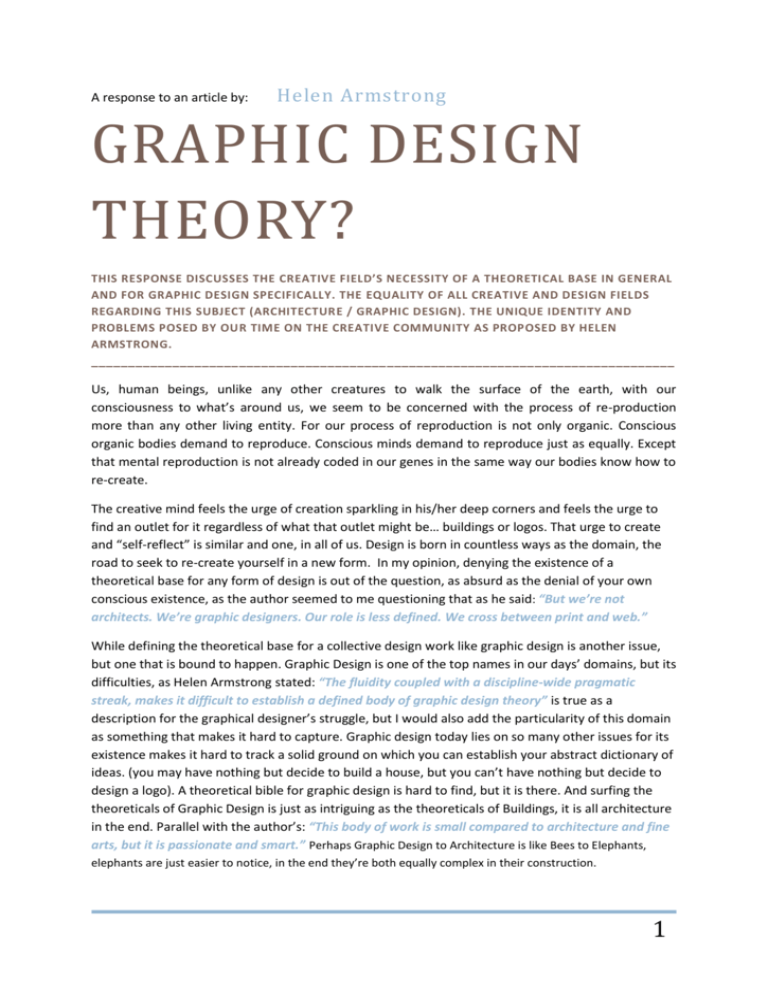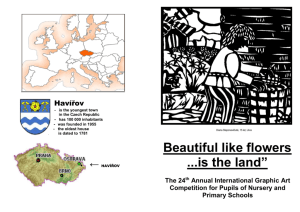Alhaffar_Hadi-Response
advertisement

A response to an article by: Helen Armstrong GRAPHIC DESIGN THEORY? THIS RESPONSE DISCUSSES THE CREATIVE FIELD’S NECESSITY OF A THEORETICAL BASE IN GENERAL AND FOR GRAPHIC DESIGN SPECIFICALLY. THE EQUALITY OF ALL CREATIVE AND DESIGN FIELDS REGARDING THIS SUBJECT (ARCHITECTURE / GRAPHIC DESIGN). THE UNIQUE IDENTITY AND PROBLEMS POSED BY OUR TIME ON THE CREATIVE COMMUNITY AS PROPOSED BY HELEN ARMSTRONG. _______________________________________________________________________________ Us, human beings, unlike any other creatures to walk the surface of the earth, with our consciousness to what’s around us, we seem to be concerned with the process of re-production more than any other living entity. For our process of reproduction is not only organic. Conscious organic bodies demand to reproduce. Conscious minds demand to reproduce just as equally. Except that mental reproduction is not already coded in our genes in the same way our bodies know how to re-create. The creative mind feels the urge of creation sparkling in his/her deep corners and feels the urge to find an outlet for it regardless of what that outlet might be… buildings or logos. That urge to create and “self-reflect” is similar and one, in all of us. Design is born in countless ways as the domain, the road to seek to re-create yourself in a new form. In my opinion, denying the existence of a theoretical base for any form of design is out of the question, as absurd as the denial of your own conscious existence, as the author seemed to me questioning that as he said: “But we’re not architects. We’re graphic designers. Our role is less defined. We cross between print and web.” While defining the theoretical base for a collective design work like graphic design is another issue, but one that is bound to happen. Graphic Design is one of the top names in our days’ domains, but its difficulties, as Helen Armstrong stated: “The fluidity coupled with a discipline-wide pragmatic streak, makes it difficult to establish a defined body of graphic design theory” is true as a description for the graphical designer’s struggle, but I would also add the particularity of this domain as something that makes it hard to capture. Graphic design today lies on so many other issues for its existence makes it hard to track a solid ground on which you can establish your abstract dictionary of ideas. (you may have nothing but decide to build a house, but you can’t have nothing but decide to design a logo). A theoretical bible for graphic design is hard to find, but it is there. And surfing the theoreticals of Graphic Design is just as intriguing as the theoreticals of Buildings, it is all architecture in the end. Parallel with the author’s: “This body of work is small compared to architecture and fine arts, but it is passionate and smart.” Perhaps Graphic Design to Architecture is like Bees to Elephants, elephants are just easier to notice, in the end they’re both equally complex in their construction. 1 “Users approach software and the web with the expectation of filling in their own content and shaping their own visual identities” As said earlier, design by the proposed definition is a form of self-reproduction. And in the same sense we don’t question the uniqueness of every born child, we don’t question the uniqueness of born design and architecture. As a matter of fact, there might be more space for self-reflection in graphic design more than there is in other forms and this already allows for so much more freedom and self-expression (leaving aside cliental demands that are common everywhere). The produced pieces of work are easier to control and handle, judging also by the relatively smaller number of elements to be found there. So with the enormous spread of design language and means today throughout the World Wide Web, it has indeed become easier for the tools and frameworks necessary to be available for everyone, anywhere,”That transfer of knowledge is threatening to some, liberating to others.” While I do understand the concern of some artists and creative people, I do not accept this concern, nor do I acknowledge it. The availability of these frameworks especially in graphical design for it is clearer in it than in others, even though it may be called by “the template mind”, remains liberating as described for many. If anything, this liberation has solved a flaw that was in the creative graphical community, which is the usage of what is public right for everyone, as a monopoly object. The social growth today raises the bar for creative people as it pushes everyone to be more self-improving and self-demanding to bring the best out of themselves. If anyone feels not like going through such a race then it is a matter of a personal choice but it is never a possibility to define others as “creative class” in any domain while leaving others out, much like taking the title of “human” from others. On another subject, the technological advancements and their effects on us as designers as the new “common language of hybridity and “remixability”” is one not to be taken shallowly or simply. This rapid change can be of bad consequences as the machine is slowly starting to take essential roles and sometimes control over the design process, especially with the going fact that we’re living in a generation that is devestated by the loss of internet or computer machines, one that is slowly backing away from the drawing board and to tablets, tactile monitors and virtual painting. Eventually designs are thought-of, drawn, created, modified and finished virtually, and with the loss of REAL human contact and collaboration, is no one really alarmed by media activist Kalle Lasn’s warning: “We have lost our plot. Our story line. We have lost our soul.” I believe that saying that such advancement is one that is “giving us both more power and less” is enough. For it isn’t about counterbalancing here. What’s positive is encouraged and emphasized, and what’s negative is fought with resistance and problem solving –dear problem solvers- and not with simply throwing in more positive points. “We all write more today than we did 15 years ago”… I would like to approach this idea not as the addition of a new skill but as a modification to precedent. I believe that using the same logic, we talk less than we did 15 years ago. Communication has evolved to take a new shape. Ideas used to fly around and the possibility for something to remain acoustically long enough for someone to take it to existence was a low one. Unlike today where every idea and connection is recorded, registered and saved. The soil from which the creative community nurtures is widely spread and available always and eventually “The expansion of written communication makes possible thoughtful contributions to the larger discourse of design by a wider slice of the design population” 2





